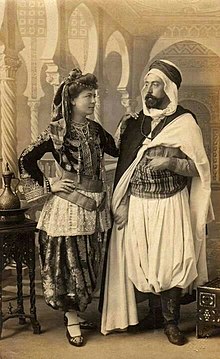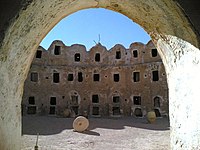
North Africa is a region encompassing the northern portion of the African continent. There is no singularly accepted scope for the region, and it is sometimes defined as stretching from the Atlantic shores of the Western Sahara in the west, to Egypt and Sudan's Red Sea coast in the east.
The history of Western Sahara can be traced back to the times of Carthaginian explorer Hanno the Navigator in the 5th century BC. Though few historical records are left from that period, Western Sahara's modern history has its roots linked to some nomadic groups such as the Sanhaja group, and the introduction of Islam and the Arabic language at the end of the 8th century AD.

Berbers, or the Berber peoples, also known as Amazigh or Imazighen, are a diverse grouping of distinct ethnic groups indigenous to North Africa who predate the arrival of Arabs in the Maghreb. Their main connections are identified by their usage of Berber languages, most of them mutually unintelligible, which are part of the Afroasiatic language family.

The Bedouin, Beduin, or Bedu are pastorally nomadic Arab tribes who have historically inhabited the desert regions in the Arabian Peninsula, North Africa, the Levant, and Mesopotamia (Iraq). The Bedouin originated in the Syrian Desert and Arabian Desert but spread across the rest of the Arab world in West Asia and North Africa after the spread of Islam. The English word bedouin comes from the Arabic badawī, which means "desert-dweller", and is traditionally contrasted with ḥāḍir, the term for sedentary people. Bedouin territory stretches from the vast deserts of North Africa to the rocky ones of the Middle East. They are sometimes traditionally divided into tribes, or clans, and historically share a common culture of herding camels, sheep and goats. The vast majority of Bedouins adhere to Islam, although there are some fewer numbers of Christian Bedouins present in the Fertile Crescent.

The Arab world, formally the Arab homeland, also known as the Arab nation, the Arabsphere, or the Arab states, comprises a large group of countries, mainly located in West Asia and North Africa. While the majority of people in the Arab world are ethnically Arab, there are also significant populations of other ethnic groups such as Berbers, Kurds, Somalis and Nubians, among other groups. Arabic is used as the lingua franca throughout the Arab world.

The Sahara is a desert spanning across North Africa. With an area of 9,200,000 square kilometres (3,600,000 sq mi), it is the largest hot desert in the world and the third-largest desert overall, smaller only than the deserts of Antarctica and the northern Arctic.

The Maghreb, also known as the Arab Maghreb and Northwest Africa, is the western part of the Arab world. The region comprises western and central North Africa, including Algeria, Libya, Mauritania, Morocco, and Tunisia. The Maghreb also includes the disputed territory of Western Sahara. As of 2018, the region had a population of over 100 million people.
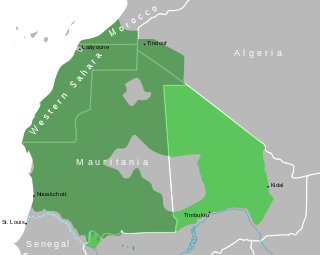
Beni Ḥassan is a Bedouin Arab tribe which inhabits Western Sahara, Mauritania, Morocco and Algeria. It is one of the four sub-tribes of the Banu Maqil who emigrated in the 11th century from South Arabia to the Maghreb with the Banu Hilal and Banu Sulaym Arab tribes. In the 13th century, they took the Sanhaja territories in the southwest of the Sahara. In Morocco, they first settled, alongside their Maqil relatives, in the area between Tadla and the Moulouya River. The Sous Almohad governor called upon them for help against a rebellion in the Sous, and they resettled in and around that region. They later moved to what is today Mauritania, and from the 16th century onwards, they managed to push back all black peoples southwards to the Senegal Valley river. The Beni Hassan and other warrior Arab tribes dominated the Sanhaja Berber tribes of the area after the Char Bouba war of the 17th century. As a result, Arabs became the dominant ethnic group in Western Sahara and Mauretania. The Bani Hassan dialect of Arabic became used in the region and is still spoken, in the form of Hassaniya Arabic. The hierarchy established by the Beni Hassan tribe gave Mauritania much of its sociological character. That ideology has led to oppression, discrimination and even enslavement of other groups in Mauritania.
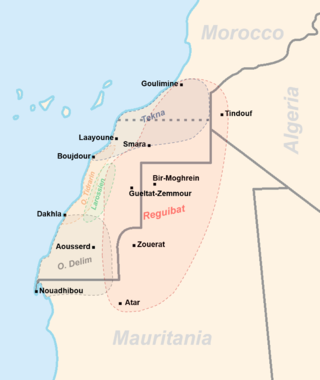
The Sahrawis, or Sahrawi people, are an ethnic group native to the western part of the Sahara desert, which includes the Western Sahara, southern Morocco, much of Mauritania, and along the southwestern border of Algeria. They are of mixed Hassani Arab and Sanhaji Berber descent, as well as West African and other indigenous populations.
Maghrebi Arabic, often known as ad-Dārija to differentiate it from Literary Arabic, is a vernacular Arabic dialect continuum spoken in the Maghreb. It includes the Moroccan, Algerian, Tunisian, Libyan, Hassaniya and Saharan Arabic dialects. Maghrebi Arabic has a predominantly Semitic and Arabic vocabulary, although it contains a significant number of Berber loanwords, which represent 2–3% of the vocabulary of Libyan Arabic, 8–9% of Algerian and Tunisian Arabic, and 10–15% of Moroccan Arabic. Maghrebi Arabic was formerly spoken in Al-Andalus and Sicily until the 17th and 13th centuries, respectively, in the extinct forms of Andalusi Arabic and Siculo-Arabic. The Maltese language is believed to have its source in a language spoken in Muslim Sicily that ultimately originates from Tunisia, as it contains some typical Maghrebi Arabic areal characteristics.

Arabization or Arabicization is a sociological process of cultural change in which a non-Arab society becomes Arab, meaning it either directly adopts or becomes strongly influenced by the Arabic language, culture, literature, art, music, and ethnic identity as well as other socio-cultural factors. It is a specific form of cultural assimilation that often includes a language shift. The term applies not only to cultures, but also to individuals, as they acclimate to Arab culture and become "Arabized". Arabization took place after the Muslim conquest of the Middle East and North Africa, as well as during the more recent Arab nationalist policies toward non-Arab minorities in modern Arab states, such as Algeria, Iraq, Syria, Egypt, Bahrain, and Sudan.

The history of North Africa has been divided into its prehistory, its classical period, the arrival and spread of Islam, the colonial period, and finally the post-independence era, in which the current nations were formed. The region has been influenced by many diverse cultures. The development of sea travel firmly brought the region into the Mediterranean world, especially during the classical period. In the 1st millennium AD, the Sahara became an equally important area for trade as camel caravans brought goods and people from the south of the Sahara. The region also has a small but crucial land link to the Middle East, and that area has also played a key role in the history of North Africa.

The Haratin, also spelled Haratine or Harratin, are an ethnic group found in western Sahel and southwestern Maghreb. The Haratin are mostly found in modern Mauritania, Morocco, Western Sahara, Senegal, and Algeria. In Tunisia and Libya, they are referred to as Shwashin.
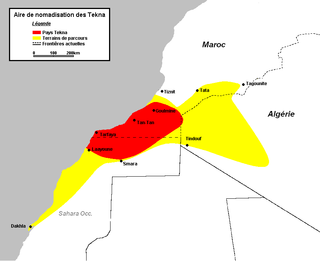
The Tekna is a semi-nomadic Sahrawi tribal confederation of mixed Arab and Lamta Sanhaja Berber origins. Its constituents today inhabit southern Morocco, northern Western Sahara and western Algeria, but traditionally with wider migration routes.
Arabized Berbers are Berbers whose language is a local dialect of Arabic and whose culture is Arab culture, as a result of Arabization.

Arab Muslims are the Arabs who adhere to Islam. They are the largest subdivision of the Arab people and the largest ethnic group among Muslims globally, followed by Bengalis and Punjabis. Likewise, they comprise the majority of the population of the Arab world. Currently, around 93% of Arabs are Muslims, while the rest are mainly Arab Christians, as well as Druze and Baháʼís.

Maghrebi Arabs or North African Arabs are the inhabitants of the Maghreb region of North Africa whose ethnic identity is Arab, whose native language is Arabic and trace their ancestry to the tribes of the Arabian Peninsula. This ethnic identity is a product of the centuries-long Arab migration to the Maghreb since the 7th century, which changed the demographic scope of the Maghreb and was a major factor in the ethnic, linguistic and cultural Arabization of the Maghreb region. The descendants of the original Arab settlers who continue to speak Arabic as a first language currently form the single largest population group in North Africa.
The following lists events that happened during 2020 in North Africa. The countries listed are those described in the United Nations geoscheme for Africa: Algeria, Egypt, Libya, Morocco, Sahrawi Arab Democratic Republic, Sudan, Tunisia, and Western Sahara

The trans-Saharan slave trade, also known as the Arab slave trade, was a slave trade in which slaves were mainly transported across the Sahara. Most were moved from sub-Saharan Africa to North Africa to be sold to Mediterranean and Middle Eastern civilizations; a small percentage went in the other direction.
The Arab migrations to the Maghreb involved successive waves of migration and settlement by Arab people in the Maghreb region of Africa, encompassing modern-day Algeria, Libya, Morocco and Tunisia. The process took place over several centuries, lasting from the early 7th century to the 17th century. The Arab migrants hailed from the Middle East, particularly the Arabian Peninsula, with later groups arriving from the Levant and Iraq.

